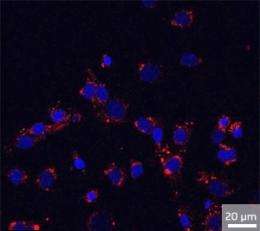Robust approach for preparing polymer-coated quantum dots

Quantum dots (QDs) are tiny crystals of semiconducting material that produce fluorescence. The color or the wavelength of the fluorescence is dependent on the size, shape and composition of QDs. Larger QDs tend to emit light at the red end (longer wavelengths) of the electromagnetic spectrum. As the size of the QDs decrease, so does the wavelength of emitted light. This tunability of emission wavelength is one reason why QDs have become popular for use as fluorescent markers in biological research. For example, scientists can attach QDs to single molecules and cells and track their movements over time using fluorescence microscopy.
Dominik Jańczewski, Nikodem Tomczak and Ming-Yong Han at the A*STAR Institute of Materials Research and Engineering and co-workers have now described a protocol for the preparation of quantum dots coated with an amphiphilic polymer — a polymer that contains both water-attracting and -repelling components. “Our aim is to develop a robust approach for the preparation of QD for use as fluorescent tags for bioimaging, sensing and therapeutics,” says Han. “The method we have developed is applicable to any nanoparticles, not just QDs.”
Most biological applications require the use of QDs that disperse and remain stable in an aqueous solution. Conventional approaches for synthesizing QDs typically endow the QDs with a coating of hydrophobic ligands, which are repelled by water. Although it is possible to exchange the ligands after synthesis, a ligand shell that is exchangeable is, by its very nature, unstable and might result in the release of toxic materials, such as cadmium, into solution.
Instead of exchanging the ligands, an alternative method to make the QDs disperse in water is to coat them with a polymer that has both hydrophilic and hydrophobic parts. This works on the simple principle that like attracts like — or in other words, hydrophobic parts of the polymer attract hydrophobic ligands that stabilize the QDs, and hydrophilic parts of the polymer attract water molecules in solution.
The new protocol describes the procedure in detail and aims to provide the benefits of the research team’s experience in QD synthesis to others whose interests might be focused more on applications rather than the development of synthetic methods. The synthesis of the polymer coating allows the incorporation of a wide variety of functional groups. “In the future we hope to work towards image guided therapy,” says Han. “QDs could be prepared that not only produce an image of cancer cells, but also release drugs at such a target.”
More information: Jańczewski, D., Tomczak, N., Han, M.-Y. & Vancso, G. J. Synthesis of functionalized amphiphilic polymers for coating quantum dots. Nature Protocols 6, 1546–1553 (2011).
Provided by Agency for Science, Technology and Research (A*STAR)


















